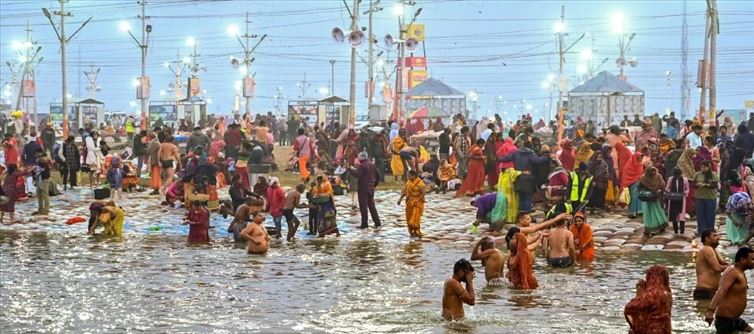
To ensure the ganga is "dip-safe" during the maha Kumbh, the pollution Control Board tests river water samples every day, separates flowers and pooja materials from water around the clock, installs a 200-kilometer temporary drainage system to channel all greywater to treatment facilities, and uses cutting-edge technology to handle human waste.
Mega Religious Event
Every twelve years, Prayagraj hosts the mega-religious festival known as maha Kumbh, which begins on january 13 and lasts for forty-five days. At the Sangam, where the ganga, Yamuna, and Saraswati rivers converge, almost eight crore visitors have already taken a sacred plunge. Officials predict that 50 lakh people will arrive on big bath days, such as Mauni Amavasya on january 29.
According to the authorities, these tourists are anticipated to produce over 240 million liters of greywater (wastewater from cooking, washing, and bathing) and approximately 16 million liters of fecal sludge per day. vivek Chaturvedi, the maha Kumbh Mela's Additional district Magistrate (ADM), claims that the river water is completely safe to use for the sacred plunge.
Every day, a crew from the pollution control board tests river samples from several ghats, and the levels are within acceptable bounds. Flowers, coconuts, and other items presented as part of ceremonies are among the pooja garbage that ends up in the rivers, which is the second area of focus. To fish these out of different ghats, we have placed equipment there.
"To keep the river and the ghats clean, a group of ganga Sevadoots are positioned on the ghats and are responsible for collecting and disposing of the waste as soon as possible. They have rotating shifts," he continued. Officials from the Uttar Pradesh government claim that out of the Rs 7,000 crore the state government is spending on the Kumbh mela this year, Rs 1,600 crore has been set aside specifically for waste and water management.
200 KM Temporary Drainage System
The administration is also taking steps to install 1.45 lakh toilets, build prefabricated faecal sludge treatment plants (FSTPs) to handle the waste and sludge collected in makeshift septic tanks of toilets, install temporary and permanent sewage pipelines, create water treatment ponds, deploy sludge carrying vehicles, and use other cutting-edge technologies. A 200-kilometer temporary drainage system will be set up to channel all greywater to treatment facilities.
Technology created by the indian Space Research Organization (ISRO) and the Bhabha Atomic Research Centre (BARC) is being used by authorities to handle greywater and human waste, particularly feces. "We're making sure the water is always suitable for bathing. BOD (Biological oxygen Demand), or batting quality, should be less than three (units) in accordance with the rules and regulations. The more impurities, the higher the BOD. Manoj Kumar Singh, the chief secretary of Uttar Pradesh, told PTI that impurity takes the form of organic particles.
Mega Religious Event
Every twelve years, Prayagraj hosts the mega-religious festival known as maha Kumbh, which begins on january 13 and lasts for forty-five days. At the Sangam, where the ganga, Yamuna, and Saraswati rivers converge, almost eight crore visitors have already taken a sacred plunge. Officials predict that 50 lakh people will arrive on big bath days, such as Mauni Amavasya on january 29.
According to the authorities, these tourists are anticipated to produce over 240 million liters of greywater (wastewater from cooking, washing, and bathing) and approximately 16 million liters of fecal sludge per day. vivek Chaturvedi, the maha Kumbh Mela's Additional district Magistrate (ADM), claims that the river water is completely safe to use for the sacred plunge.
Every day, a crew from the pollution control board tests river samples from several ghats, and the levels are within acceptable bounds. Flowers, coconuts, and other items presented as part of ceremonies are among the pooja garbage that ends up in the rivers, which is the second area of focus. To fish these out of different ghats, we have placed equipment there.
"To keep the river and the ghats clean, a group of ganga Sevadoots are positioned on the ghats and are responsible for collecting and disposing of the waste as soon as possible. They have rotating shifts," he continued. Officials from the Uttar Pradesh government claim that out of the Rs 7,000 crore the state government is spending on the Kumbh mela this year, Rs 1,600 crore has been set aside specifically for waste and water management.
200 KM Temporary Drainage System
The administration is also taking steps to install 1.45 lakh toilets, build prefabricated faecal sludge treatment plants (FSTPs) to handle the waste and sludge collected in makeshift septic tanks of toilets, install temporary and permanent sewage pipelines, create water treatment ponds, deploy sludge carrying vehicles, and use other cutting-edge technologies. A 200-kilometer temporary drainage system will be set up to channel all greywater to treatment facilities.
Technology created by the indian Space Research Organization (ISRO) and the Bhabha Atomic Research Centre (BARC) is being used by authorities to handle greywater and human waste, particularly feces. "We're making sure the water is always suitable for bathing. BOD (Biological oxygen Demand), or batting quality, should be less than three (units) in accordance with the rules and regulations. The more impurities, the higher the BOD. Manoj Kumar Singh, the chief secretary of Uttar Pradesh, told PTI that impurity takes the form of organic particles.




 click and follow Indiaherald WhatsApp channel
click and follow Indiaherald WhatsApp channel